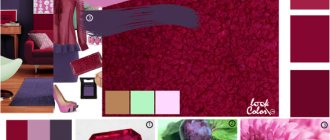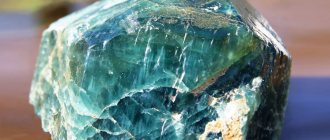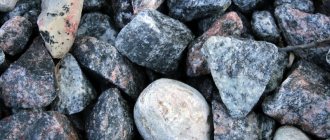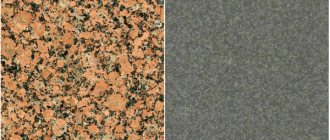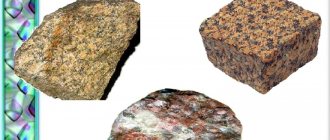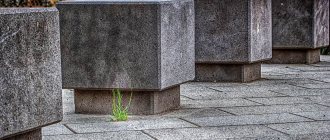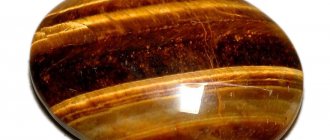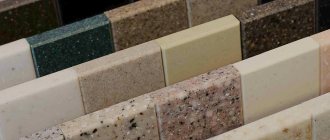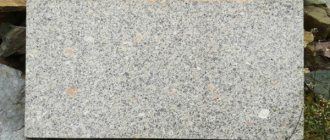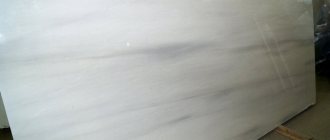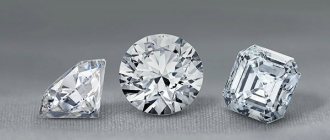Granite (translated from Latin as “grain”) is the most common rock of igneous origin. Granite rock makes up most of the earth's crust; Many varieties of granite are used in construction, glass and ceramics, architecture and art. Granite is twice as strong as marble and is inert to atmospheric phenomena - this is the reason for the huge number of buildings, structures and monuments made from this crystalline rock. The Lenin Mausoleum in Moscow, St. Isaac's Cathedral and the Alexandria Column in St. Petersburg are made of granite stone.
Granite classifications
Because granite is formed within the earth's crust due to the movement of tectonic plates, it is subject to high temperatures and intense pressure. Under such conditions, the main components of the rock - feldspar and quartz - are mixed with other minerals located in the earth's crust. Depending on what minerals and in what proportion are present in the material, granites can have different colors, differ in composition and structural features. Many types of granite are known to science; to understand their diversity, there are generally accepted classifications:
- by color;
- by structure;
- by chemical composition;
- by inclusions;
- at the place of production.
Granite: origin of the rock
Granite belongs to rocks of igneous origin, characterized by a mixed composition. The stone is widespread in the continental part of the earth's crust and forms the basis of most of all continents.
Scientists believe that granite began to form in the bowels of the planet more than 300 million years ago. Granite is a rock of heterogeneous nature, which means it is formed in two ways:
— As a result of crystallization of liquid magmatic melt;
— In the process of transformation of igneous rocks under the influence of several factors - pressure and high temperature.
Under the influence of tectonic stress, magma rose into the upper layers of the earth's crust, forming future deposits of this stone. Subsequently, the liquid magma solidified, and its constituent elements crystallized, forming modern granite - a rock of the highest hardness and density. These two processes shaped the structure of the stone over millions of years. Initially, the rock lay at great depth, but now, thanks to the uplift of rocks, granite deposits are exposed and come to the surface.
The third highest mountain in the world (after Chomolungma and Chogori), Mount Kanchenjunga consists of granite. The height of its peak is 8586 meters;
By color
Granite rock always contains quartz and feldspar. There may also be other minerals mixed with the main components as a result of metamorphism during the formation of the stone. The most common minerals found in this rock are biotite, hornblende, mica, amphiboles, iron oxides, and garnet. The color of granite depends on which elements and in what quantities are contained in the ore.
Feldspar usually varies in color from rock to rock - it can be composed of one or more minerals (microcline, orthoclase, plagioclase). Its content in granite ore varies between 10-65%. Quartz can make up 20 to 60 percent of a rock, but in most cases its content is between 25 and 30 percent.
Granite blanks of different colors
The lower the quartz content, the darker the granite that is formed at the output. This stone is not completely black. Near granite deposits you can find black igneous gabbro rock, which is sometimes classified as granite due to its structural similarity.
White granite
The white color of the rock is a sign of high quartz content in the ore. It cannot be completely white - granite ore always contains inclusions of various minerals. Most often, white granite stone contains amphibolites, light feldspar, and mica. On a cut, the play of shades can be easily distinguished. The inclusions are usually gray, blue or green.
White granites are not recommended for exterior decoration of buildings. Due to their structure, they have significant porosity, which means they will absorb dirt and dust. However, this type of breed finds excellent use in interior decoration and the manufacture of decorative crafts.
Black granite
Black granite has an elegant appearance and is used for both interior and exterior decoration. Among other things, it is in demand in the manufacture of ritual products, monuments, paths and platforms.
The dark color of the rock means minimal quartz content (about 20%). This granite stone always contains veins of lighter colors. Very often, black granite refers to gabbro, although technically it is not granite, since it contains almost no quartz. However, in structure and physical and chemical characteristics it is close to granite.
Gray granite
Gray or light gray granite is the most common type of stone. It is found much more often than other types, has excellent characteristics, and is unpretentious in use and care. It is used for the manufacture of monuments and slabs, interior and exterior finishing materials, and landscaping of courtyards. It consists predominantly of plagioclase and has a spotted pattern. It can have both cold and warm shades of color, the inclusions are most often yellowish, brown, or light green.
Gray granite wall
Beige granite
Beige granite is a combination of light yellow and pink rocks. Quartz is present in sufficient quantities; iron oxides and mica may be contained. Its beige color is given by its high feldspar content. It is used mainly for interior decoration, although you can find facade cladding made with this material. The color varies from light beige to yellow-brown with a predominance of light tones.
Blue granite
Blue granite is one of the rarest types of stone. Most often this means light blue, gray-blue or blue granite interspersed with other minerals. Sometimes larvikite or anorthosite containing inclusions of labradorite is found under the guise of blue granite. True blue granite is highly valued in the design industry. Used for interior decoration, decorative decorations. It has a high cost due to its rarity.
Brown granite
Brown granite is another type of natural stone. The color comes from the minerals contained in the rock. There are coffee, caramel, dark sand and chocolate tones. One of the most unpretentious types to process and use - practically no dirt is visible on its surface. It is used for both interior and exterior decoration of buildings, as well as for arranging playgrounds and paths. The design goes well with brick and wood.
Yellow granite
The color of yellow granite stone can vary from light sand to golden and even orange. This color is given to it by iron oxide, which is often found in the composition. Used primarily for interior decoration of bathrooms, kitchens, countertops, fireplaces and window sills. It is rarely used for exterior decoration, since due to unfavorable atmospheric factors, iron particles in the material may rust, and the shade of the rock will change over time, becoming more orange.
Green granite
Green granite is the rarest type of stone. It is as rare as true blue granite. Due to its rarity, it is highly valued. Under the guise of green granite, green marble or green soapstone can often appear - these rocks are much more common. The green color of the rock can be given by the mineral amazonite, which is occasionally present in the composition. True green granite ranges in color from light green to dark green, with streaks of white, grey, blue and dark brown. Can be used for both external and internal decoration, the manufacture of decorative elements and art objects.
Red granite
Red granite is one of the common types of this rock. The color indicates the abundance of iron oxide or microcline in the stone's composition. Shades range from pale pink to deep scarlet. Due to its relative prevalence and beautiful appearance, it is used everywhere - for finishing rooms, facades, stairs, paths, making decorative elements and paving stones.
Memorial complex made of granite
Black granite
Black granites can have a uniform structure or have minor inclusions of gray, white and brown colors. Often dark granites are used in ritual themes or in the design of entrance areas of hotels and business centers.
Black color is quite practical, it is not afraid of accidentally spilled wine stains or juice, which is why it is so popular in the manufacture of countertops for bathrooms and kitchens. Among other things, black types of this mineral in its raw form are used for cladding plinths and entrance areas. Black color is universal, it can be combined with any colors and materials, so if you want to get an interior that will be relevant for several decades, give your preference to this color.
By structure and composition
Granite is almost always a stone with a pronounced granular pattern, although sometimes there are rocks with a single-color or layered structure. As for the grain structure, the following types of granites are distinguished based on their size:
- fine-grained (2-3 mm);
- medium-grained (4-5 mm);
- coarse-grained (over 5 mm).
The smaller the grain size, the better the physical and chemical characteristics of a particular breed. Fine-grained material is stronger and more inert to atmospheric influences.
Depending on the structural features and composition, the following types of granite stone are distinguished:
- Gneissic
. It has a uniform fine-grained structure and contains mica flakes, thanks to which it shines in the sun. - Muscovite
. Contains three main minerals: quartz, muscovite and orthoclase. - Pegmatoid
. It is characterized by a uniform structure of equal-sized grains of quartz and feldspar measuring 2-3 mm. - Porphyritic
. It contains elongated or isometric inclusions of orthoclase and quartz, which differ significantly in size from the groundmass minerals. - Finnish, or rapakivi granite
. It is a porphyritic rock in which inclusions of orthoclase and quartz are surrounded by a greenish-gray rim of oligoclase.
White granite
White granite is especially in demand when designing kitchen interiors; pure white color is extremely rare, so in the bulk this mineral is found interspersed with gray, brown and gray colors. Natural density and its excellent physical characteristics make the stone indispensable for finishing bathrooms and kitchen interiors. White granite slabs located at the head of the bed or in the living room area can transform the surrounding space beyond recognition.
The price of white granite is lower than its artificial counterparts, which allows you not to save when choosing finishing materials for the kitchen or bathroom. The most common types of white granite are Bella White, Indian Grant Kashmir White and New River White.
By inclusions
Depending on the inclusions of dark-colored minerals, colored granite is divided into several varieties. The most common of them are:
- Alaska
. Does not contain dark-colored minerals, the predominance of potassium-sodium feldspar and biotites is pronounced. - Hornblende or hornblende-biotite
. Contains hornblende, sometimes combined with biotite. - Plagiogranite
. A type of rock containing predominantly plagioclase. It is characterized by a light gray color and the greatest prevalence.
There are other types of granite rock:
- mica;
- double mica;
- augite;
- graphite;
- diopside;
- malacolithic;
- pyroxene;
- epidote;
- hypersthenic.
What determines the color of granite?
What gives granite such a variety of colors? In this article we will try to learn not only about the color, but also the mineralogy and origin of the stone. Whether you're looking for granite for your countertops or curiosity brings you here, the variety of natural granite will amaze you.
Granite is widely used in interior and exterior decoration. Every day we see, but no longer notice it in the subway, on the embankment, street or square, hotel, concert hall, museum or country house. Floors, countertops, window sills and fireplaces made of natural granite have become part of our lives due to their natural beauty, durability and environmental friendliness. Thousands of years of use have confirmed its reliability and durability. It will add strength, luxury and status to any building and interior.
By place of production
Granite deposits are distributed throughout the world. The bulk of granite ore is mined in Russia, Ukraine, Central Asia, central Europe, the USA and Africa. In Russia alone there are over 200 deposits, most of which are located in the Urals, Karelia, the Far East and Siberia.
The most famous deposits in the CIS are:
- Amazonite
. Contains rare and valuable raw materials from which green and blue granite stone is extracted. - Leznikovskoe
. It is famous for its iron and microcline content, the color of the raw materials is red, pink. - Korninskoe, Sofievskoe
. Light granite is mined in many shades.
Granite mining
This rock is found on all continents of our planet, and the stone is mined using open-pit mining. Extensive deposits of granite are found in Europe, Russia, Turkey, North America and Asian countries. Raw materials mined in different regions vary significantly in color, structure and mineral composition.
There are several mining methods - the choice of a specific rock extraction technology depends on the depth of its occurrence. Currently, the following methods of granite mining are used in the world:
- Rock blasting;
- Breaking off rock fragments with an air cushion;
- Development using stone cutters;
- Burocline method of development;
- "Silent explosion" technology.
Each of these methods has its own advantages and disadvantages: with the use of blasting, for example, it is possible to extract only low-grade stone of a fine fraction (crushed stone), and the use of burocline technology makes it possible to obtain massive blocks that will become raw materials for granite slabs. The extracted stone requires further processing - cutting, polishing, heat treatment, polishing and grinding.
Ural granite
One of the largest concentrations of granite ore deposits is located in the Urals. Development is carried out from more than 12 mines, the most famous of which are Tashmurunsky, Mansurovsky, Sanarsky, Yuzhno-Sultaevsky, Malyshevsky, Sosnovy Bor and Tsvetok Ural. The age of the mined rocks is about 2.5 million years.
Most Ural granite rocks are gray and light gray in color. The exception is the Malyshevsky, Yuzhno-Sultaevsky and Zapadno-Sultaevsky granites, which have red and pink colors. The lightest of all Ural rocks is Mansurovskaya. The Ural deposits of granite stone are famous for their low, almost zero radioactivity, which allows the material to be used everywhere. Iron content varies from mine to mine - this must be taken into account when choosing a particular material for a specific purpose.
Ural granite has a relatively low cost, which allows it to be used even in road construction. They often decorate premises, building facades, make architectural forms, monuments and decorative elements.
Gray granite
What color of granite to choose largely depends on the color preferences of the customer and his budget; the most common deposits are gray, black and brown, which explains their relatively inexpensive cost.
The natural strength of this stone allows it to be used in the finishing of houses, entrances and urban spaces; its resistance to constant climate change has become widespread in the finishing of embankments, metro stations, squares and park paths. The gray mineral from the Pokostovskoye and Yantsevskoye deposits is widely used in the production of paving stones, curbs , city bollards, balls and other barriers.
Approximately half of all mined granites are used for the production of all kinds of finishing slabs, steps, and blocks; Rock fragments are used to make paving stones, crushed stone, and crumbs of various fractions.
Gray granite tiles are used for finishing entrance lobbies, facades, plinths, for lining fountains and paving embankments. Gray colored species are often used in interior decoration; floors, walls, countertops and window sills are made from them.
Karelian granite
Karelia is also a rich region for high-quality granite stone. More than 10 large deposits are being developed in Karelia, the most famous are Dymovskoye, Vinga, Kupetskoye, Elizovskoye, Sopka Buntina. Red-pink and dark colors of the stone predominate. There is also a Gabbro-Diabase deposit, the raw materials of which are in demand for the manufacture of ritual products. This stone does not change its appearance for decades and looks good at any time of the year.
Karelian granite is well suited for most applications of this natural stone: it is used to pave squares, used in urban design, and used for exterior cladding of commercial buildings. It is used to make paving stones, small architectural forms, and decorative elements. They make monuments, memorial slabs, tiles and parapets.
Granite and its varieties
Looking at photographs of granite stone samples, you may be surprised by the variety of color shades and structure of this stone! For a long time, the usual color range of available varieties was not so diverse - stones of black, gray, reddish and green colors were presented on the market. The appearance of such a stone did not evoke aesthetic delight, so granite was treated as an affordable and reliable building material. After granite mined outside our country appeared on the market, consumers were able to fully appreciate the aesthetics and decorative properties of this mineral.
Now buyers can purchase granite in delicate pastel shades and rich unusual colors. For example, the rare Blue Pearl granite, mined in Norway, is distinguished by its uniform structure and unusual blue color. Granite of the "Golden Persian" variety is more reminiscent of beige marble, and the "Australia Blue" variety is more like noble malachite. The varieties of stone mined in Brazil, Iran, and India look especially impressive. The Brazilian granite “Azul Bahia”, “Azul Macaubas” attracts with its unique color scheme and amazing designs, the Indian variety “Andromeda White” resembles concrete in structure and color, and the Iranian variety “Verde Bargonia” looks like a real painting! Currently, hundreds of varieties of this stone are known, products from which are ready to decorate the interiors of houses.
Common types of granite
The most common types of granite stone in the world include:
- "Santa Sicily"
. It has reddish inclusions due to the content of dark biotite. - "Ubatuba"
. The Brazilian grade of granite ore is known for its high mica content, due to which it has a very dark color. - "White cashmere"
. In addition to white feldspar and quartz, it contains garnet crystals, which gives it a unique appearance. - "Golden Brown"
. Contains a potassium variety of spar with amphibolite inclusions. - "Venetian Gold"
. Contains white and yellow feldspar, as well as amphibolite, quartz, mica and garnet. - "Black Pearl"
. The composition includes gabbro, pyroxene and amphibolite. - "Black Galaxy"
. A type of fine-grained gabbro, diluted with yellow inclusions. - "Bianco Antico"
. Contains large amounts of quartz with pink feldspar content.
Types and names of colored granite
Leznikovsky - medium grain size makes this variety the most durable. The palette ranges from pale brown to dark red.
Dymovsky is a brown (close to brown) shade with pinkish inclusions.
Maslovsky - dark olive greenish color interspersed with black.
Maple Red is one of the most popular options, coarse-grained, rich red, with the help of heat treatment you can achieve a soft pink color, the main advantages are low water absorption and heat resistance.
Types of granite surface treatment
Granite stone can be processed in different ways using special tools. The type of granite processing determines how smooth the treated surface will be. Some processing methods are intermediate in nature, while others bring the material to the state of the finished product.
Polished Red and Gray Granite
- Burching
. This is the treatment of granite surfaces using a drum sander, resulting in a rough, slippery polished surface. This method is often used to create anti-slip stairs and floor coverings. The height difference can be up to 5 mm. - Polishing
. The surface is treated with fine abrasives, resulting in matte granite. With this processing, the rock pattern is clearly visible. It is used in the manufacture of floor coverings, garden paths, and facade cladding. - Sawed surface
. This is an intermediate stage of processing, during which a height difference of up to 5 mm is possible. The granite slab is cut on machines or using circular saws, resulting in a rough surface. - Polishing
. A common type of processing to obtain a smooth surface with a mirror finish. Processing is carried out using powder-coated tools, as well as cloth and felt circles. - Heat treatment
. After thermal exposure to a granite slab, a rough top layer is formed, on which the rock pattern is clearly visible. The height difference varies from 2 to 5 mm. This is how granite steps and transitions are processed. - Grinding
. Grinding allows you to obtain a relatively smooth surface on which traces of an abrasive tool are visible. The height difference is 2 mm. Sanding is used to make flooring, garden paths and steps. - Texture "Rock"
. This processing is carried out by chipping large pieces of granite rock with a height difference of up to 200 mm. The result is an imitation of natural rock chips. It is used in finishing plinths, making ritual items, and in decorative elements.
Properties of granite
Thanks to the physical and chemical processes occurring in the bowels of the Earth, granite acquired its unique properties;
- Hardness;
- Frost resistance;
- High density (from 2.65 to 3.2 g/cm3);
- Low moisture absorption coefficient.
According to the Mohs scale, the hardness of the stone is estimated at 6 - 7 points - the stone is second in hardness only to topaz, corundum and diamond. There are no scratches left on the surface of granite from any sharp objects, which makes it an indispensable material for finishing work. Due to its high density and compression resistance, the mineral is used for the production of products subject to significant mechanical stress. The moisture resistance of the mineral is used in the manufacture of fountain bowls, swimming pools and embankment landscaping. The low level of moisture absorption indirectly affects another important property of the mineral - its frost resistance: it practically does not absorb moisture and can be used at extremely low temperatures. It should also be noted that the mineral is not afraid of high temperatures: only at temperatures above 1200 C does it become brittle and begin to crumble. An important property is chemical inertness: even when heated and in contact with chemicals, the mineral does not release any toxic compounds into the environment. It is completely environmentally friendly and harmless to both human health and nature.
Granite is used to produce stones for the ice sports game of curling. The production uses stones of a special grade “Blue Hone”
Making monuments from granite
Over the many years of our workshop's existence, we have accumulated a large, diverse portfolio of finished works, from which you can choose the most optimal option for a slab and pedestal in terms of quality and cost.
Also, our clients can always express individual wishes regarding the stone or design of the tombstone. Experienced and qualified specialists turn into reality even sketches independently developed by the client with precision down to the smallest detail.
Our company always strives to comply with all technologies for the manufacture of monuments, so the end result will not only become a worthy frame for the grave, but will also preserve the memory of a loved one for many decades.
Options for using granite in different colors
The most popular stones are gray and beige shades. These colors are universal, practical, they harmoniously combine with the entire palette and are suitable for the manufacture of monuments, finishing materials, paving stones, and decor. Light breeds are the most affordable. They are used to decorate living rooms, bathrooms, kitchens, building facades, entrances, and public spaces.
Darker rocks look massive and prestigious, so they are widely used in commercial construction. The finish can withstand weathering and abrasive loads. Special processing gives the stone anti-slip properties, which allows it to be laid on street stairs and sidewalks.
The characteristics and descriptions of stones of different shades are almost the same, so when choosing, you should only take into account the design requirements of a specific project.
What form is there for a monument, and which one is best suited for granite?
There is a difference between the types of materials: they differ in properties and external characteristics. But one more parameter should be taken into account - ease of processing and susceptibility to cracking during grinding. It is necessary to correlate the properties of the stone and the shape of the tombstone, to evaluate whether it will be possible to make something worthwhile from such material. Form options:
- rectangular monuments: the most suitable type of granite products, since they are difficult to process, while a rectangle is easier to make, due to the absence of complex elements and small parts;
- figured monuments: among the varieties of tombstones made of hard rock, there are products containing rounded parts, elements; special tools and equipment are used for processing, and granite blanks with lower hardness and density are selected to make them easier to grind;
- obelisks: a type of monument, characterized by an elongated shape, narrowing towards the top, it is not difficult to make this option from a granite block, it is straight, does not contain roundings;
- statues and sculptures: contain many complex elements, small details, granite sculptures look rougher than marble ones, so it is better to choose other rocks for artistic structures;
- Pokostovsky granite: it is versatile, lasts a long time, is hard, but contains an insufficiently large proportion of quartz, which affects the complexity of processing; you can create products of different configurations (but within reason, without the need to perform painstaking work);
- Cornish: in basic parameters it is not inferior or superior to other types of breed in this group, but it is distinguished by the relative ease of processing (can be polished, exposed to temperature);
- labradorite: called moonstone, it is distinguished by an attractive appearance - rainbow tints are visible, high hardness is also noted, and feldspar acts as the main component, which reduces the strength of the product;
- Finnish granite: universal, used in various fields, the main advantage is the variety of shades, interesting structure, otherwise this variety is similar to others in its main characteristics;
- Aurora: considered the most durable among Indian breeds, but at the same time attractive, suitable for making tombstones of simple shapes;
- Baltic Green: the variety is not inferior to the previously discussed (Aurora) in strength and hardness, therefore it is also recommended to use it only for products of simple shapes;
- Balmoral Red: the strength of stone sculptures of this type is not extreme, but above average, so it is better to consider this breed for creating simple tombstones, it will be easier to work with them;
- Indian granites: represented by different types, most of which are durable, some options are leaders among the rocks of this group (compressive strength 300 MPa), they are difficult to process, but you can always make a simple-shaped tombstone;
- Indian Black (Absolute Black): bending strength - 312 MPa, stone sculptures are very hard, resist mechanical loads, it is difficult to work with them, it is enough to make a simple design;
- Gandhi: the breed is considered one of the most attractive, distinguished by its black-red hue, oblong veins, but at the same time the product will be durable and will last a long time;
- Aurora Indian and Tiffany: the materials are distinguished by excellent external characteristics, the second of the options especially stands out, its structure is very unusual, which is due to the presence of curvilinear veins of significant length in a bright color (closer to green), Aurora Indian is more often found in a red shade with black spots;
- monuments from several varieties of granite: most often made to order, using several types of rocks, but they are considered to create different parts (tombstone, gravestone, vase, flower bed).
Gravestone, monument
Mineralogical composition of granite.
Granite includes a wide range of minerals. Acid plagioclase is rock-forming minerals, aluminosilicates from the feldspar group. Plagioclases are a series of extreme member minerals, which are albite Na(AlSi3O8) abbreviated Ab and anorthite Ca (Al2Si2O8) (abbreviated An). Typically, the composition of the rock is designated by a number corresponding to the anorthite content as a percentage. Albit No. 0 – 10; oligoclase No. 10 – 30; andesine No. 30 – 50; Labrador No. 50 – 70; bitovnit No. 70 -90; anorthitis No. 90 – 100.
Quartz
Which granite is better? 10 most popular types of granite
Granite is one of the most common rocks. It belongs to the type of acidic magmatic, consists of three main minerals:
- quartz – up to 35%;
- plagioclase (potassium feldspar) – up to 65%;
- mica (biotite or muscovite) – up to 10%.
In addition, granite may contain minor and accessory minerals. The predominant colors of the stone are red, gray, pink, green, yellow, interspersed with white and black.
According to the degree of granularity, granite is divided into three types according to the size of inclusions:
- fine-grained (1.5-2 mm);
- medium-grained (2-10 mm);
- coarse-grained (more than 10 mm).
In terms of hardness and strength, the stone occupies one of the first places among all technical rocks. Due to its low water absorption rate, granite is very frost-resistant and is not susceptible to contamination.
What granites are most often used
Various types of granite are used in construction, architecture and landscape design, for example, for:
- production of foundation blocks, paving stones, paving slabs;
- external decoration of walls, columns, stairs and balustrades, as well as embankments within the city;
- cladding walls, floors, fountains and fireplaces.
- and much more.
The ten most commonly used types of granite stone include:
1 - Yuzhno-Sultaevsky
A variety with one of the most beautiful and expressive color shades. It is mined in the Southern Urals. An excellent material for cladding walls, entrance steps, monumental columns, balustrades, plinths of respectable passage areas.
2 - Kurdai
A “monumental” grade of granite, from which the facades of dozens of buildings of “Stalinist architecture” are made inside the boulevard ring of Moscow, as well as monuments and houses in other Russian cities. It is mined in Tajikistan and Kazakhstan.
3 - Ladozhsky
“Forge” grade of stone, which, due to its proximity and ease of polishing, was the first to be used by builders in finishing decorative elements of the historical center of St. Petersburg. All embankments and marinas of the city are finished, among other varieties, with Ladoga granite.
4 - Mansurovsky
One of the “whitest” and fine-grained of all granite varieties. An ideal building material for the manufacture of paving slabs.
5 - Kapustinsky
A variety that demonstrates a real riot of colors. In the mid-50s of the last century, this stone was the main building material for the construction of monumental buildings in the center of Moscow. The facades of most “Stalinist high-rises” are decorated with it.
6 – Ala-Noskua
The so-called “border” granite is mined from a deposit located in the Leningrad region. A technical grade suitable for the manufacture of pedestals, curbs, paving slabs, cornices, steps, parapets.
7 - Isetsky
A stone that has a perfect gray color. Microscopic white inclusions give it a smoky hue. The stone, which is mined near Yekaterinburg, is one of the most economical of all that are used for exterior decoration.
8 – Gabbro
Black Karelian granite with white-gray smoky inclusions of the middle fraction. The variety that marked the beginning of the mass use of granite in monumental construction.
9 - Dymovsky
Dymovsky granite has a pleasant chocolate hue interspersed with shiny golden particles. This granite lends itself well to polishing and sawing. Also, thanks to the presence of shining inclusions, it looks great when split.
10 – Garnet amphtbolite
This granite is mined in northern Russia. It is popular for both exterior and interior decoration. The pattern of the stone consists of inclusions of garnet, burgundy and dark stripes. The natural ornament of each cut is unique and very interesting.
We have listed the 10 most popular varieties of granite in Russia. But this is not a complete list of stone options that we offer to our clients. Contact our consultants to get information about all available varieties and choose the one that suits you best.
